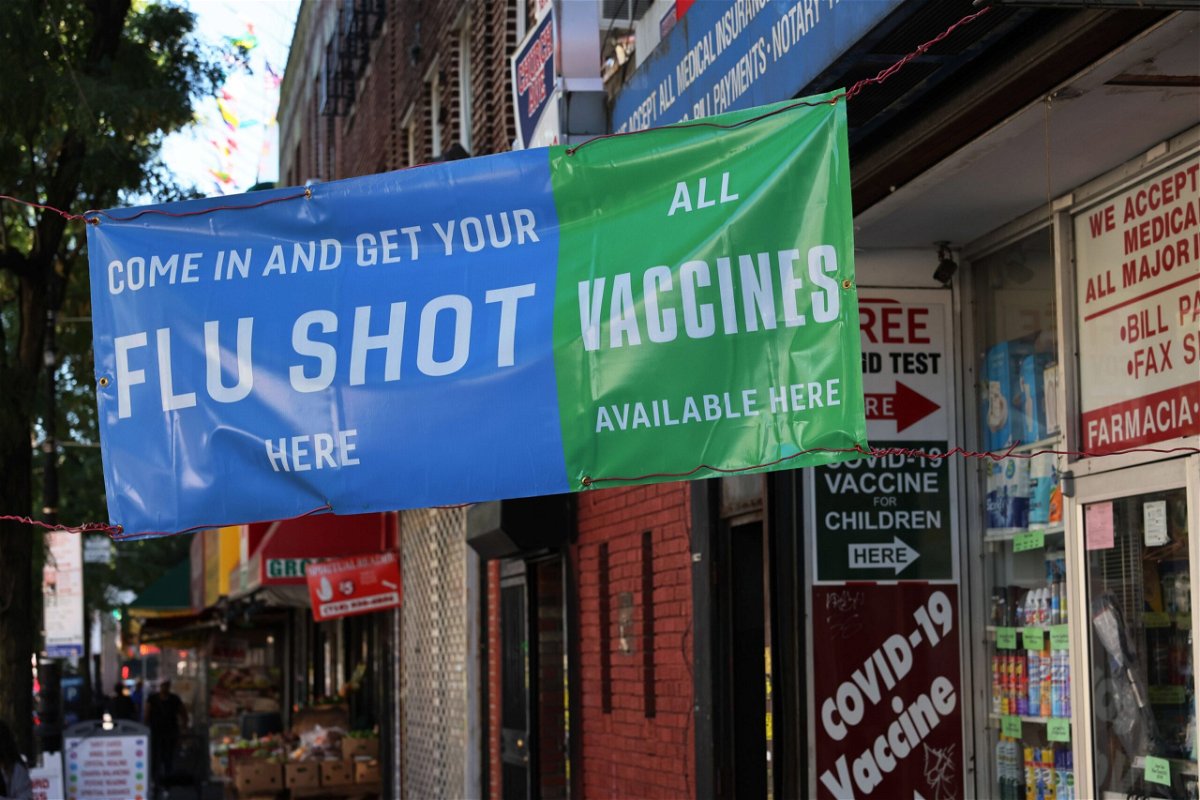COVID-19 vaccination rates lag behind flu’s, but getting shots together may help

By Meg Tirrell, CNN
(CNN) — Every year since 2010, the US Centers for Disease Control and Prevention has recommended that everyone in the country ages 6 months and older receive a flu vaccine.
But that has resulted in just fewer than half of all adults and about 58% of kids getting the shot each year, according to CDC data.
COVID-19 vaccines have a ways to go to catch up. Just 21% of US adults received a bivalent booster, the last version available before the US Food and Drug Administration authorized an updated COVID vaccine this month. Among kids, the numbers are much lower: less than 8% of everyone under 18.
“There was this very, very strong message that children were less affected than older persons,” said Dr. William Schaffner, an infectious disease specialist at Vanderbilt University. That idea, and the newness of the vaccines, “along with, I’m afraid, the political veneer that COVID vaccination acquired, resulted in much less acceptance of COVID vaccination in children.”
Even among older adults, who have a higher uptake of COVID vaccines, the rate doesn’t rival flu’s: About 43% of people 65 and older got the bivalent COVID-19 booster, compared with the two-thirds of people in that age group who typically get their seasonal flu shot.
As the US moves toward an annual model for updating COVID vaccines that resembles the seasonal update for flu shots, the chief executive of vaccine maker Moderna said he expects that the higher rate of vaccination for flu could pull COVID vaccination rates higher, as well.
“We believe pharmacists and doctors are going to recommend to somebody who walks into a pharmacy and says, ‘I would like a flu shot please,’ to say, ‘Don’t you want a COVID shot as well?’ ” Stephane Bancel told CNN last week. “We have to see where the numbers end up … but I think it’s going to be more than last year.”
Pfizer, conversely, has forecast that fewer Americans will receive COVID vaccines this year compared with 2022 — 24% overall vs. 31% last year, in its analysis — but that the availability of a two-in-one COVID-flu shot in a few years will help raise COVID vaccination rates.
“Starting in ‘25 and continuing in ‘26 and beyond, we expect to see an increase in COVID-19 vaccination rates, assuming the successful development and approval of the COVID/flu combination product,” Pfizer CEO Albert Bourla said on the company’s quarterly earnings conference call in January. “A successful introduction of a COVID/flu combo could, over time, bring the percentage of Americans receiving the Covid-19 vaccine closer to the portion of people getting flu shots.”
Moderna also plans to roll out a combined COVID and flu shot, with data expected by the end of this year from an early-stage clinical trial. If studies go well, Bancel said, that combination shot could also be ready for the fall season of 2025.
Novavax, which is awaiting FDA authorization of its updated COVID vaccine, also says it’s testing a combination COVID-flu vaccine. Its version uses older, protein-based technology, whereas Moderna and Pfizer’s flu and COVID vaccines both use mRNA.
People in the US can get COVID and flu vaccines at the same appointment now; they’re just two separate shots. But it’s something public health officials recommend for the convenience factor alone.
“For a lot of folks out there, it is easier to come in once and get them both at the same time, rather than having to come back,” Dr. Nirav Shah, principal deputy director of the CDC told CNN. “If you can get both shots on the same day, one in your left arm, one in your right arm, that’s the way to do it.”
As COVID hospitalizations rise, CDC estimates presented at its meeting of vaccine advisers last week suggest that a broad recommendation for updated COVID vaccines will prevent 40,000 deaths and 400,000 hospitalizations — and not just among seniors. Making the recommendation for everyone 6 months and older, rather than just those 65 and up, would prevent 15,000 more deaths and 200,000 more hospitalizations in the next two years, the estimates show.
And while public health experts hope the higher flu vaccination rates help more people get updated COVID shots, they’re not satisfied with flu rates, either.
Reaching two-thirds of those 65 and older with the flu shot “is a substantial achievement,” Schaffner said. “But it still leaves a third of people undervaccinated.”
The-CNN-Wire
™ & © 2023 Cable News Network, Inc., a Warner Bros. Discovery Company. All rights reserved.